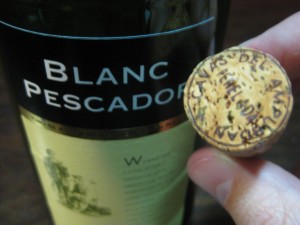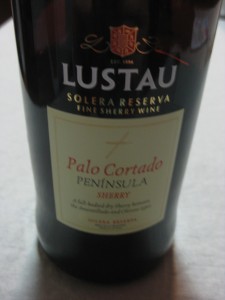 This week is full of grapes that won’t register in my brain if they were listed together on a sheet of paper. Macabeo is one grape that’s instrumental in every teenager’s life at the discovery of Cava but still manages to stay under the radar since it’s almost never on the label. “Cava” shows up quite a bit on the label (or the cork in this case), even though this wine isn’t a true Cava. It’s a vino de aguja aka a petullant aka a frizzante aka a fizzy wine. Not really a fully bubbly but a half bubbly, this wine has bubbles that hang around together at the surface of the wine but don’t follow the beads of bubbles that a fully fizzy wine like Champagne or a true Cava has. This one has bubbles that randomly swagger to the surface instead of following ant-like the trail of their effervescent cousins.
This week is full of grapes that won’t register in my brain if they were listed together on a sheet of paper. Macabeo is one grape that’s instrumental in every teenager’s life at the discovery of Cava but still manages to stay under the radar since it’s almost never on the label. “Cava” shows up quite a bit on the label (or the cork in this case), even though this wine isn’t a true Cava. It’s a vino de aguja aka a petullant aka a frizzante aka a fizzy wine. Not really a fully bubbly but a half bubbly, this wine has bubbles that hang around together at the surface of the wine but don’t follow the beads of bubbles that a fully fizzy wine like Champagne or a true Cava has. This one has bubbles that randomly swagger to the surface instead of following ant-like the trail of their effervescent cousins.
Taste
Enough about fizzy wine though, this Blanc Pescador wine actually has 3 grapes. The only one with 50% power is the Macabeo since the other two place around in that 25% range and won’t be mentioned. The smell on this wine isn’t the typical acidic nose of a seafood wine, which is curious with a name like “White Fisherman” (the translation of Blanc Pescador). This wine smells a lot more like peaches and full bodied fruit, even though it’s taste is that fresh and constant taste you’d want in a wine that stacks up to shellfish (PEI mussels in my case). How they managed to stuff nectarines and yuzu into this wine and keep it looking clean as a light yellow gemstone I have no idea. Nevertheless, they succeeded with this wine and even after an hour of pouring a glass there are a few bubbles undulating up to the surface. Weird.
Grape
There’s really nothing I’ve said about the grape other than it’s part of Cava but there is a fair amount about Macabeo. Like it’s name isn’t Macabeo outside of Spain – it’s Viura (scallop in Spanish, which is perhaps why they called it something else, despite it pairing well with scallops). They grow it along the southern un-trendy part of France in Languedoc-Roussillon, in the Rioja region and south of Barcelona where the Cava fields bubble happily in the sun (at least that’s how I imagine it).
Detail Up!
Blanc Pescador by Castillo Perelada
Google Randoms
* The hottest lady in wine crushes on this “cinderella wine” in her spare time.
* This is the white wine they mostly plant in northern Spain so if you’ve ever had a White Rioja, chances are you’ve had this
* This Blanc Pescador wine made the Top 16 list of Best Vinos de Aguja. No idea who decided Top 16 was better than Top 10 or Top 20. Top 16 Wines – catchy.
